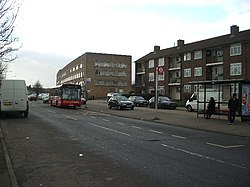Hainault
| Hainault | |
| Essex | |
|---|---|
 Hainault housing | |
| Location | |
| Grid reference: | TQ445915 |
| Location: | 51°36’13"N, -0°5’15"E |
| Data | |
| Post town: | Ilford / Chigwell |
| Postcode: | IG6, IG7 |
| Dialling code: | 020 |
| Local Government | |
| Council: | Redbridge |
| Parliamentary constituency: |
Ilford North |
Hainault is a suburban town in Essex within the Greater London conurbation, located 12½ miles north-east of Charing Cross.
History
Toponymy
The name Hainault was recorded as 'Henehout' in 1221 and 'Hyneholt' in 1239. It is Old English and means 'wood belonging to a religious community', referring to the ownership of Hainault Forest, part of the larger Epping Forest, by Barking Abbey. The spelling was altered from the 17th century because of a false connection to Philippa of Hainault, the wife of Edward III.[1]
Development
The area was mainly forested, it was owned by Barking Abbey and formed part of the Royal Forest of Essex. The large density of forest meant the area was predominately used for the provision of timber for building ships and houses. A decline in demand for timber, and a greater demand for food, led in 1851 to an Act of Parliament authorising the deforestation of much of Hainault Forest. Within six weeks 3,000 acres of woodland was cleared.[2]
Urban development began after August 1856, when the Great Eastern Railway built a line between Stratford and Loughton. In 1903, from the line at Woodford Junction, a loop line to Ilford was opened. Hainault was one of the stations on that line.
Although it had been hoped that housing development would ensue from the building of the railway, it was a long time coming. Hainault station was closed from 1908, five years after opening; development began in the late 1920s, and the station was reopened in 1930. As a result of the London Passenger Transport Board New Works Programme 1935–40 (not completed until 1948 because of World War II) the line was taken over from the LNER and converted for use by London Underground trains.
Because of the lack of available land the London County Council (LCC) was permitted to build housing and act as landlord outside of its territory. It purchased land in Chigwell, Dagenham, and Ilford in 1943. Building of the Hainault Estate commenced after the Second World War from 1947 to 1953. The development of 2,779 houses was in the style known as a 'cottage estate' with the names of the roads relating to the history of Hainault Forest.[3]
References
- ↑ Anthony David Mills (2001). Oxford Dictionary of London Place Names. Oxford University Press. ISBN 0-19-280106-6. http://books.google.co.uk/books?id=DSIOAQAAMAAJ.
- ↑ http://www.hainaultforest.co.uk/3Forest%20of%20Essex.htm
- ↑ Cherry, Bridget (2005). London: East. New Haven, CT London: Yale University Press. ISBN 0300107013.
This Essex article is a stub: help to improve Wikishire by building it up.